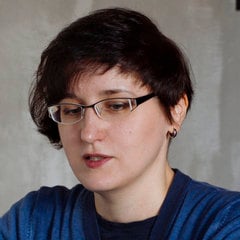Discover legacy content from FontShop.com, preserved for your reference.
Each of your typefaces is distinguished by simplicity of form, functionality, and originality. Where do you find inspiration?
Gayaneh: In graphic design. We follow what’s going on in this area, and try to develop a sense of the direction it is heading to, the potential needs in typefaces and empty niches. We consider our work as part of graphic design, and not as some independent abstract area—this is very important. Of course, we also follow what other type designers do and draw our own conclusions. In general, font development is participation in a common graphical process where everyone influences one another, and the best way is to play this game consciously.

Most of our fonts are indeed very functional, but not all. For example, the Wermut font is more an artistic expression than a “workhorse”. Nowadays, the functionality by itself is no longer sufficient for a type designer. There are many functional fonts that successfully fulfill their tasks—there is no sense in creating the same thing. Our aim is that our fonts would not only “work”, but that they also would carry a fresh artistic idea. If we don’t manage to find a new bright image, we don’t issue such a typeface.
As creator and mastermind extraordinaire of Serebro Nabora, the Moscow type conference, what is your perspective on the type design and font market in general?
Gayaneh: The Serebro Nabora conference has nothing to do with my views on the future of type—it’s just organizational work. Answering the question: I do not expect any fundamental changes neither in the type design nor in the font market. As practice shows, the font market is very conservative, new technologies and services take root with difficulty or do not take root at all. We have already experienced a digital revolution, and, probably, this is enough for our generation. Nowadays, people generally don’t want any true revolutions, they want to finally have an opportunity to calmly drink their beer and hold meetings for the rights of rabbits in zoos. Against such social background, applied creativity turns into a glass bead game, and this is interesting in its own way. If we compare our era with the previous ones, it becomes obvious that there is some stagnation in the design overall and nothing fundamentally new happens, despite the fact that everything seems to be available for free creativity. I think this is due to the overall social need for stability, calmness, and a gradual increase in the quality of life. At such times, the focus is on quality, nuances, and game of meanings.

Who would be a dream client to design a typeface for?
Gayaneh: It so happened that we produce retail fonts, and by-and-large, we like it. Our client is the whole world, what could be better? Here it is important to understand that the typeface is only part of the work. The remaining portion is done by the graphic designer as the font user. And we are always very interested in watching this second part of the work, which we have no influence on—how the designers open up the potential inherently present in the typeface. Of course, most solutions are predictable and often are of the same type. But sometimes we encounter unconventional and unexpected examples, and this is probably the most pleasant part in the profession of a type designer. With some fonts, it is very easy to work with. For example, the Formular always looks good wherever you put it—no special typographic skills are needed. Yet, for the Wermut, we have not yet seen any bright solutions, we are waiting for a designer to appear who will really expose this typeface.
Outside of the world of type, letters and language what excites you?
Gayaneh: As a human being, I’m excited about lots of things which have absolutely nothing to do with design, it hardly makes sense to talk about it. But if we talk about adjacent areas, then, first of all, this is a fine art. I have two art educations, and I look at the world through this prism. In the design, an artistic idea and image are of primary interest to me, the functionality is secondary. Or rather, the functionality is something to be taken for granted, it just has to be there, no questions asked. I also like other kinds of art: literature, cinema, theater, music. It is a pity that we have only one life and it is impossible to do everything you are interested in, but I think the versatile interests help: when the designer has a certain cultural background, his works become deeper.
What’s next?
Gayaneh: Everything will continue as is. So far, no fundamental changes have been planned. Perhaps, we will work a little slower, because we have higher standards for our work, but otherwise, everything is going to remain as it is.
Thank you, Gayaneh!


